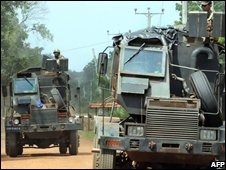 In May 2009 Sri Lanka’s government declared victory in its 26-year war with Tamil Tiger rebels who were fighting for a separate homeland.
In May 2009 Sri Lanka’s government declared victory in its 26-year war with Tamil Tiger rebels who were fighting for a separate homeland.
It was one of the world’s bloodiest and longest-running civil wars and it left parts of the island devastated and displaced hundreds of thousands of people.
On the eve of the first presidential election since the war ended, BBC News examines what is at stake for the people of Sri Lanka.
Who are the main election candidates?
There are 22 presidential candidates but two main contenders.
Sri Lanka’s President Mahinda Rajapaksa called an early election in the hope of capitalising on the wave of optimism that followed the defeat of the Tamil Tigers.
He leads the United People’s Freedom Alliance (UPFA) supported by some nationalist, Tamil and Muslim parties.
His main challenger is his former army chief and now bitter rival, Gen Sarath Fonseka. The two fell out over who should claim credit for winning the war.
Gen Fonseka has the backing of the opposition United National Front (UNF) and has also won the support of the main Tamil party, the Tamil National Alliance, seen as close to the Tiger rebels.
Analysts say the election is too close to call and the majority Sinhalese vote looks like it may be evenly split between the two.
What are the key issues in this election?
Ideologically there is little difference between Mr Rajapaksa and Gen Fonseka: both take credit for winning the war and both are steeped in the language of Sinhalese nationalism.
Issues such as press freedom, clamping down on corruption and good governance have also been part of their platform.
But this has been one of the most violent elections in recent history, rights groups say, with many incidents of intimidation.
Gen Fonseka has said he will relinquish certain executive presidential powers if elected.
The economy is also a factor – growth fell considerably last year and rising unemployment and a high cost of living has contributed to voter disgruntlement.
What about the Tamil vote?
Both candidates have made promises in the hope of securing Tamil votes – they make up 12% of the population and some analysts say they could play a decisive role.
But neither candidate has promised any significant devolution of power to Tamil areas in the north and east of the country.
They have made promises to address Tamil concerns but these have not been translated into manifesto commitments.
Meanwhile, tens of thousands of Tamils displaced by the war are still confined to camps in the north. Tamil political parties complain they have not been give proper voter identity cards
More than 150,000 others have been released from camps but they too have been demanding a faster pace of rehabilitation.
What happens next?
Polls close at 1600 local time on Tuesday, 26 January and Sri Lanka’s election commission says it expects to have finished counting all the votes by the early hours of Wednesday.
If no candidate has 50% plus one vote after the first count, second preferences will be tallied and the candidate with the greatest number of votes wins.
What challenges face the next president?
Relief and reconstruction for the parts of the north and east devastated by decades of war will be high on the list for the next president.
Areas devastated by the conflict need to be de-mined and rebuilt. Hundreds of thousands of Tamils were displaced in the final stages of the war.
Many of these have now been released but say they need help with rebuilding their homes and with their livelihoods. Those left in camps are eager to be allowed back home.
Then there are the questions regarding a political settlement for minority Tamils.
Sri Lanka’s next president will also face international pressure to investigate war crimes allegations.
Both sides in the conflict were accused of repeatedly ignoring the plight of tens of thousands of people trapped by the fighting.
The rebels denied using civilians as "human shields", while the army rejected accusations it was guilty of indiscriminate shelling.
What were the Tamil Tigers fighting for?
The rebels started fighting in the 1970s for a separate state – Eelam – for Tamils in Sri Lanka’s north and east.
They argued that Tamils had been discriminated against by successive majority Sinhalese governments.
The rebels were among the most disciplined and organised guerrilla groups in the world in recent times. They had their own "capital", ground forces, navy and even a rudimentary air force.
They honed the tactic of suicide bombings to deadly effect and became a proscribed terrorist group in many countries.
Have the rebels been eliminated?
The government says the rebels have been crushed. For the first time in decades, the army now controls the whole of Sri Lanka’s territory.
The rebel movement is over as a conventional military force and its leadership has been decimated.
But the Tamil Tigers controlled huge financial and logistical resources, and are supported by many expatriate Tamils around the world.
Analysts say that the manner in which the government pursued victory – ignoring international calls for restraint – may have radicalised a new generation of Tamils, both on the island and in the diaspora in Europe, Asia and North America.
What was the human and economic cost of the war?
The conflict killed well in excess of 70,000 people, displaced hundreds of thousands more and held back the island’s growth and economic development.
(For updates you can share with your friends, follow TNN on Facebook and Twitter )
